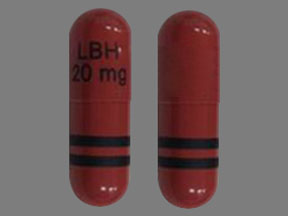Farydak Side Effects
Generic name: panobinostat
Medically reviewed by Drugs.com. Last updated on May 29, 2023.
Note: This document contains side effect information about panobinostat. Some dosage forms listed on this page may not apply to the brand name Farydak.
Applies to panobinostat: oral capsule.
Warning
Oral route (Capsule)
Severe diarrhea has been reported with panobinostat. Monitor for diarrhea, institute antidiarrheal treatment, interrupt therapy, then reduce the dose or discontinue panobinostat if necessary for severe diarrhea. Severe and fatal cardiac ischemic events, severe arrhythmias, and ECG changes have occurred in patients receiving panobinostat, and electrolyte abnormalities may exacerbate arrhythmias. A baseline ECG and electrolyte panel is recommended, along with periodic monitoring during treatment as clinically indicated.
Serious side effects of Farydak
Along with its needed effects, panobinostat (the active ingredient contained in Farydak) may cause some unwanted effects. Although not all of these side effects may occur, if they do occur they may need medical attention.
Check with your doctor immediately if any of the following side effects occur while taking panobinostat:
More common
- Abdominal or stomach pain or tenderness
- black, tarry stools
- bloating or swelling of the face, arms, hands, lower legs, or feet
- clay colored stools
- confusion
- cough or sore throat
- dark or bloody urine
- decreased appetite
- decreased frequency or amount of urine
- dizziness, faintness, or lightheadedness especially when getting up suddenly from a lying or sitting position
- fast, irregular, pounding, or racing heartbeat or pulse
- fever, chills, or sweating
- headache
- increased thirst
- itching or skin rash
- loss of appetite
- lower back or side pain
- muscle spasms or twitching
- nausea or vomiting
- nervousness
- painful or difficult urination
- pinpoint red spots on the skin
- pounding in the ears
- rapid breathing
- seizures
- severe diarrhea
- slow or fast heartbeat
- swelling of the face, fingers, feet, or lower legs
- tingling of the hands or feet
- trouble breathing
- ulcers, sores, or white spots in the mouth
- unusual bleeding or bruising
- unusual tiredness or weakness
- unusual weight gain or loss
- yellow eyes or skin
Less common
- Chest pain or discomfort
- coughing up blood
- difficulty with swallowing
- increased menstrual flow or vaginal bleeding
- nosebleeds
- pain in the shoulders, arms, jaw, or neck
- paralysis
Other side effects of Farydak
Some side effects of panobinostat may occur that usually do not need medical attention. These side effects may go away during treatment as your body adjusts to the medicine. Also, your health care professional may be able to tell you about ways to prevent or reduce some of these side effects.
Check with your health care professional if any of the following side effects continue or are bothersome or if you have any questions about them:
More common
- Acid or sour stomach
- belching or passing gas
- change or loss in taste
- depressed mood
- dry mouth
- hair loss
- heartburn or indigestion
- hoarseness or husky voice
- fatigue or feeling lethargic
- redness of the skin
For Healthcare Professionals
Applies to panobinostat: oral capsule.
Gastrointestinal
Very common (10% or more): Diarrhea (68%), nausea (36%), vomiting (26%)
Common (1% to 10%): Abdominal pain, dyspepsia, gastritis, cheilitis, abdominal distension, dry mouth, flatulence, colitis, gastrointestinal pain
Cardiovascular
Very common (10% or more): T-wave abnormalities (40%), ST-segment depression (22%), arrhythmia (12%)
Common (1% to 10%): Palpitations, hypotension, hypertension, orthostatic hypotension
Uncommon (0.1% to 1%): Cardiac ischemic events[Ref]
Hematologic
Very common (10% or more): Thrombocytopenia (97%), lymphopenia (82%), leukopenia (81%), neutropenia (75%), anemia (62%)
Common (1% to 10%): Grade 3/4 hemorrhage
Immunologic
Very common (10% or more): Severe infections (31%)
Common (1% to 10%): Hepatitis B
Hepatic
Common (1% to 10%): Increased blood alkaline phosphatase
Frequency not reported: Hepatic dysfunction (primarily aminotransferase and total bilirubin elevations)
Metabolic
Very common (10% or more): Hypocalcemia (67%), hypoalbuminemia (63%), hypophosphatemia (63%), hypokalemia (52%), hyponatremia (49%), hyperphosphatemia (29%), decreased appetite (28%), hypermagnesemia (27%), hyperbilirubinemia (21%), decreased weight (12%)
Common (1% to 10%): Hyperglycemia, dehydration, fluid retention, hypomagnesemia
Dermatologic
Common (1% to 10%): Skin lesions, rash, erythema
Endocrine
Common (1% to 10%): Hypothyroidism
Genitourinary
Common (1% to 10%): Urinary incontinence, hyperuricemia
Musculoskeletal
Common (1% to 10%): Joint swelling
Nervous system
Common (1% to 10%): Dizziness, headache, syncope, tremor, dysgeusia
Other
Very common (10% or more): Fatigue (60%), peripheral edema (29%), pyrexia (26%)
Common (1% to 10%): Chills
Psychiatric
Common (1% to 10%): Insomnia
Renal
Very common (10% or more): Increased blood creatinine (41%)
Common (1% to 10%): Renal failure, increased blood urea, decreased glomerular filtration rate
Respiratory
Common (1% to 10%): Cough, dyspnea, respiratory failure, rales, wheezing
More about Farydak (panobinostat)
- Check interactions
- Compare alternatives
- Drug images
- Dosage information
- During pregnancy
- FDA approval history
- Drug class: histone deacetylase inhibitors
- En español
Patient resources
Professional resources
Related treatment guides
References
1. Product Information. Farydak (panobinostat). Novartis Pharmaceuticals. 2015.
Further information
Always consult your healthcare provider to ensure the information displayed on this page applies to your personal circumstances.
Some side effects may not be reported. You may report them to the FDA.

